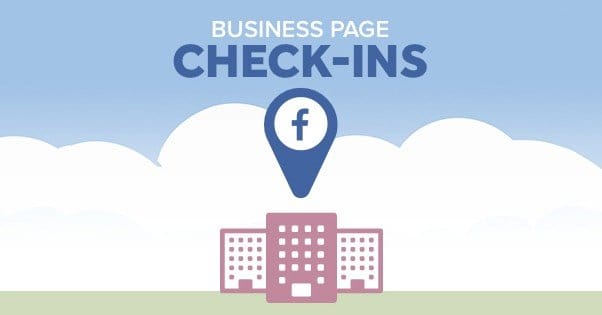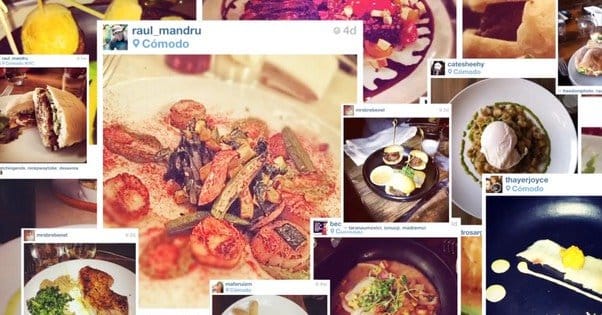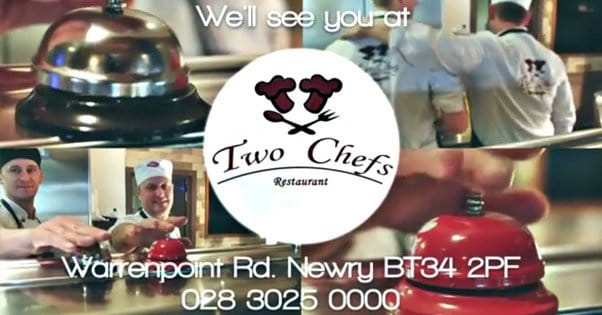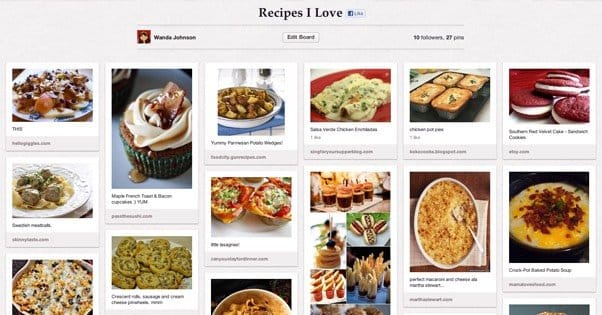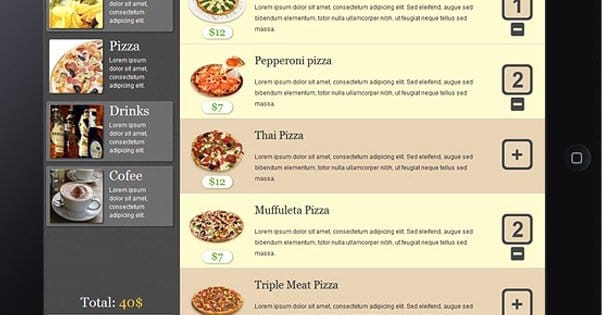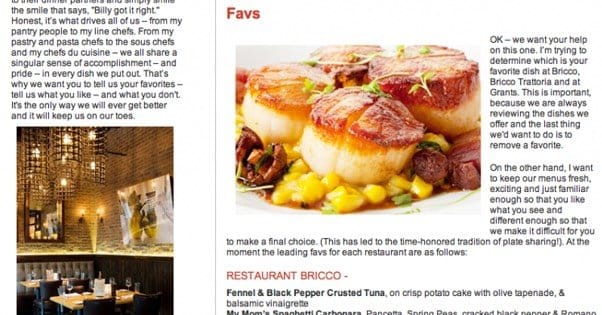 Written by ContentPowered.com
Written by ContentPowered.com
Restaurants are uniquely able to take advantage of social media, but they’re also in a fragile position; there are always competitor restaurants waiting in the wings to take over an audience and a local role as “the best X food in the city.” If you’re in charge of running restaurant marketing, you really need to do everything right. Be aggressive with your marketing and you can blast aside the competition.
1. Use Facebook with Check-Ins
Facebook is excellent for local social media, because your actual users are following you primarily. You can further attract them by allowing the check-ins and reviews system, which adds both a map and reviews to your page.
If you attract a lot of negative reviews, it’s a double-edged sword, but if you’re a good restaurant and you focus on customer service, you shouldn’t be attracting too many. Otherwise, you just need to know how to make use of Facebook as completely as possible.
2. Use Twitter for Immediate Responses
Twitter, meanwhile, is a great platform for immediate interactions. Have someone staffing it at all times and strive for a very fast response time. You’re looking for less than 5-10 minutes during your open hours, with slightly longer in the hours surrounding it. You don’t need someone staffing it four hours after you close, but you want to be able to answer simple “when do you open/close” questions directly. You also want to be able to take care of your customer service issues as quickly as possible.
3. Use Instagram for Great Images
The stereotype of the Instagram foodie posting pictures of their dinner every night isn’t the sole use of Instagram, but it’s a very good use.
You can post attractive pictures of your food, pictures of your bar in action, pictures of a full house, and an assortment of other attractive images. Don’t fall into the trap of posting unfiltered camera images, though; have someone with some graphics experience give them a run through Photoshop before you push them to the web.
4. Use FourSquare for Local Engagement
FourSquare started life as a hugely viral sensation with people becoming mayors of their local businesses, and to some extent it’s still used in that fashion. You can make use of it to reward the people who still use it, even though it has dropped off significantly in the last few years. There’s not a lot you need to do to use it, thankfully; it’s mostly user engagement. You just need to monitor it and engage back when you can.
5. Use YouTube for Excellent Videos
YouTube, and to a certain extent Instagram Videos and Vines, are all places you can throw produced promotional videos.
Use it to tease new menu items, use it to advertise upcoming specials, use it to showcase the hustle and bustle of your location. Make sure you’re actively producing videos, though, or else you’re not going to get much benefit out of YouTube beyond having a video host.
6. Use Google+ for Search Visibility
Google+ is probably one of the most important social networks to have an account on, but it’s not actually as important to use. It’s large, though not as large as Facebook, but it’s hugely integrated into Google search. If you want results in the carousel, in the local search block, or in any of the supplemental results that don’t require payment, you’re going to need to fill out your data on Google+.
7. Use Pinterest for Recipes and Pictures
Pinterest doesn’t seem like a great place for a restaurant, and I’m putting it low on the list because it really isn’t. You can, however, make good use if it if you’re willing to post your recipes, your décor aesthetic, or your commercial media in specific boards.
You can also make a board for ongoing deals, specials, events, and coupons. Just try to keep things categorized as best you can.
8. Optimize for Local Search
Local search is of the utmost importance for a restaurant, since you’re relying on having people actually come in once they visit your site or your profiles. This means primarily that you need to make your website accessible to mobile users, that you need your menu to be available, and above all, your location, hours, and other crucial information are all both accessible on any social media network and website, and are consistent between them.
9. Make Franchise Pages
If you’re a restaurant owner and part of a large chain or franchise, you still need an individual local set of social media accounts. Generally you’ll want something like Pizza Place North Ballard as an account name, and your information will need to specify which location you are. This helps you hyper-focus your ads and posting to your local audience. You have the benefit of a larger chain support, but also the local exposure.
10. Optimize Primarily for Mobile
Remember that a lot of the people looking you up on social media are going to be doing it on a phone while they decide where they want to eat.
This means they have a specific set of tasks they want to accomplish; look up hours, look up menu, make reservation, and the like. You need to provide a way for people to do all of that via mobile.
11. Post Location and Hours
It cannot be mentioned enough; you need to post your exact location and your hours of business on every social media profile and website you use, and they need to be consistent between them. Inconsistency means people are less likely to want to stop in, because they aren’t sure what information is accurate, or if any of it is. Uncertainty throws doubt on the decision, even if it wouldn’t realistically impact the decider.
12. Partner for Delivery
There are a bunch of services out there, like Seamless, Foodler, Delivery.com, and GrubHub that all allow users to make orders and schedule pickup or delivery. Partnering with one of these services will help expand your clientele and will connect you with more internet-savvy – often younger – users.
13. Offer Exclusive Deals
Offering special deals on social media, that can’t be found in location or on your basic website, is a great way to attract people to follow your social media accounts. The idea is that people show up because there’s unique value they don’t get anywhere else. The kicker is, you have to actually publish and honor those deals. This means a lot of communication and a lot of approval from the people in charge.
14. Emphasize High Quality Pictures
Whenever you’re posting a picture, be it to Instagram, Facebook, or your website, that picture needs to be top-tier.
We’re talking about the high quality DSLR pictures, not pictures taken with an iPhone. Get a real photographer and graphic artist to do the work. The more attractive your food and establishment looks, the better. Even if you have to stage a moderately busy day with employees or hired extras, do it.
15. Respond to Individuals Personally
Social media is all about social engagement. When someone posts to one of your feeds, you need to post right back. It might just be a simple confirmation or a joke, or answering a question. How you do this will be determined by the kind of persona you want to put forward, but more on that later.
16. Optimize Your Yelp Profile
Yelp is probably the number one source of social reviews, and as such you need to put a lot of work into optimizing it.
You can read a more detailed guide about doing so here. For the most part, you’re going to want to fill out and keep up to date all information. You’re also going to want to monitor reviews, both positive and negative, and do what you can to address them. You won’t be able to get all negative reviews purged, but you may want to give it a shot for some of the worst.
17. Host Social Media Contests
Contests on social media can bring in a lot of engagement, and having a prize on hand for the winners earns a lot of loyalty. Plus, you can calculate it that the prize might be a gift card of sufficient value to get people in, but not enough to cover a full order, encouraging them to spend more. What kind of contest you run is up to you and your business, though. It can be photos, it can be caption contests, it can be a raffle, or whatever else you want it to be.
18. Run Ads with Tight Geographic Targeting
Geographically targeted ads are the key to getting the most out of your money when you’re paying for ads. Don’t be afraid to pay for sponsored stories on Facebook, Twitter, and other platforms. Likewise, don’t be afraid to buy ads on Google itself. Just make sure that they’re geographically limited to the area around your location, so the only people who see them are people who are likely to stop in at some point in the future.
19. Feature and Recognize Good Employees
The “employee of the month” concept can be extended to bring you some great, high quality content. Feature your employees, do employee profiles, and recognize outstanding achievements. Make sure, however, that you’re doing this when you have a good workplace culture. If people turn it around and call you out for favoritism, underpayment, or exploitation of workers, you’ll end up losing a lot of your reputation with your community.
20. Hold User Engagement Contests
This is a specific type of contest, held on individual social media profiles rather than across all of your marketing.
The goal is to boost engagement on one social network by limiting the contest to that network alone. Tailor the contest to the sort of engagement you want from that network; photos of meals in store on Instagram, nice reviews on Facebook, and so forth.
21. Time Posts for Before the Rush
There’s a lot of information out there about social media timing, and it’s all undeniably important. One thing that separates a restaurant from a typical business is that you have a great idea of when your rush hours are. You can then time your ads and your posts to show up right before the rush, so people who might be looking for information about you will see deals, specials, and other relevant information at the top of their feeds.
22. Publicize (or Run) a Loyalty Program
There are services out there you can use to run a simple loyalty program. These eliminate the need for tracking punch cards or stamps, or for people remembering to bring one card or another. You can use apps like Perka, LevelUp or Belly for restaurant-focused loyalty programs, or work on something a little more customized with a developer.
23. Use an Email Newsletter
An email newsletter is not social media, but it’s one of the few ways you can advertise that doesn’t rely on social media, organic search, or paid ads. It’s a means of communication that only you control. That said, using social media to get people to subscribe to your newsletter, typically through contests and other forms of registration, is a great idea.
Keep an eye out on local publications, from newspapers to blogs, and monitor for positive press. When someone posts something good about your franchise or your location, reblog and republish that content. Make sure everyone sees it, even if that means having to post it more than once over the course of the following couple weeks. For Twitter you can often post the same link every day, with an “in case you missed it” prefix.
25. Reach Out to Food Bloggers
Most areas have local food enthusiasts who would love to write about the food you serve. If you’re a high profile restaurant or if you’re the kind of place they wouldn’t normally go, reach out to them and offer them a coupon in exchange for a review. You can even make it clear that you don’t demand a positive review, you’ll take an honest one, you just want the press.
26. Develop a Brand Persona
What kind of environment and clientele are coming to your restaurant? Are they higher class, expensive people who want a more professional, catering atmosphere? Are they a casual, family audience with lots of kids? Do you have a quirk, like a particular culture or a décor you’re putting forward? This will inform the kind of comments and jokes you’re able to make on your social media profiles. Cater to the audience you have.
27. Link to Your Menu
Just, seriously, make sure your menu is readable at any point. If someone visits your Facebook page, they should see your menu.
If they visit Twitter, there should be a link to your menu. If they jump to your website, they should be able to see your menu in a format they can read. We’re not just talking names of dishes, you should also have ingredients lists and prices, and even nutritional information behind a link.
28. Make Your Menu Easy to Use
I just said this, but it’s worth saying again. Your menu needs to give all the information a user might want, in a way they can see on any device. Just make sure it happens.
29. Source Local Ingredients
Particularly in small towns, local ingredients are a big selling point. When people know their local farms produce excellent vegetables, they want to know they aren’t paying you to import a bunch of ingredients they aren’t going to like as much.
30. Promote Ingredient Partnerships
When you partner with a local farm, you can broadcast that partnership and get fans of the farm to visit you, and vice versa. This is a great way to bring more local flavor and favor into your profiles.
